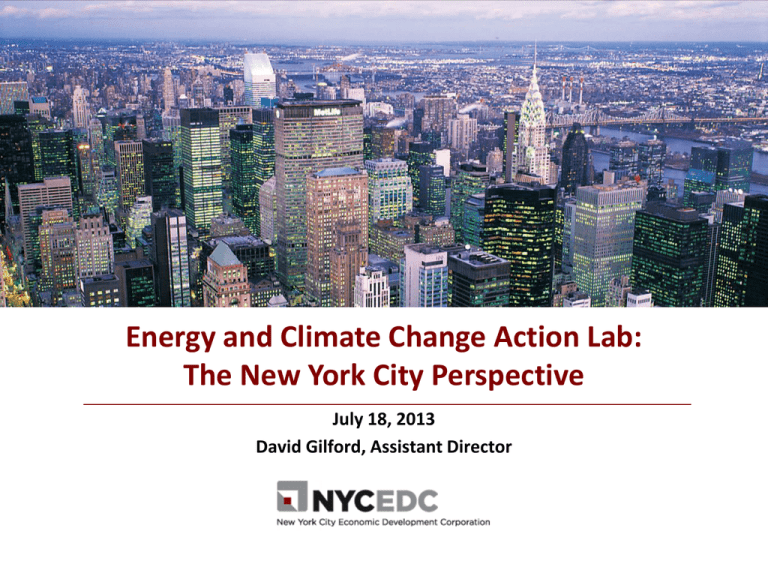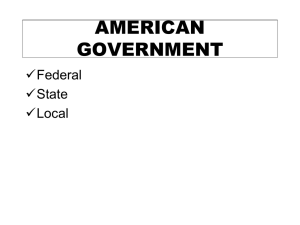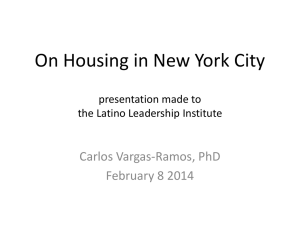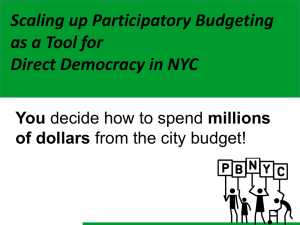David Gilford
advertisement

Energy and Climate Change Action Lab: The New York City Perspective July 18, 2013 David Gilford, Assistant Director Energy and Climate Change Action Lab: The New York City Perspective Overview Objectives for NYC Economic development Sustainability Policies for sustainability PlaNYC Greener, Greater Buildings Plan Beyond policy: stimulating innovation and adoption Open Data and Competitions Energy Aligned Clause Topics for discussion 1 NYC ECONOMIC DEVELOPMENT CORPORATION NYCEDC’s Objectives in Clean Technology and Energy Linking sustainability and economic growth Growth in employment, companies and investment while: increasing energy efficiency, expanding the production of clean energy, reducing greenhouse gas emissions, waste and pollution, and conserving water and other natural resources. Credit: NYC Mayor’s Office of Long-term Planning and Sustainability 2 NYC ECONOMIC DEVELOPMENT CORPORATION New York City’s Sustainability Objectives PlaNYC has 10 categories of goals for 2030, through 132 initiatives Neighborhoods and Housing Creates homes for almost a million more New Yorkers while making housing and neighborhoods more affordable and sustainable Parks and Public Space Ensures that all New Yorkers live within a ten-minute walk of a park Brownfields Cleans up all contaminated land in New York City Waterways Improves the quality of New York City’s waterways to increase opportunities for recreation and restore coastal ecosystems Water Supply Ensures the high quality and reliability of the water supply system Climate Change Reduce greenhouse gas emissions by more than 30% and increase the resilience of communities, natural systems, and infrastructure to climate risks Transportation Expand sustainable transportation choices and ensure the reliability and quality of the transportation network Energy Reduce energy consumption and make energy systems cleaner and more reliable Air Quality Achieve the cleanest air quality of any large U.S. city Solid Waste Divert 75% of solid waste from landfills PlaNYC is estimated to create 7,666 direct jobs annually through 2030 3 NYC ECONOMIC DEVELOPMENT CORPORATION Policies for Sustainability Energy efficiency in large buildings is critical to NYC New York City has: ~1 million buildings 15,000 properties 50k ft2 or larger, which is less than 2% of all buildings 45% of energy used citywide is in large buildings Source: NYC Mayor’s Office 4 NYC ECONOMIC DEVELOPMENT CORPORATION Policies for Sustainability PlaNYC launched 3 major energy efficiency initiatives Greener, Greater Buildings Plan (GGBP) Will reduce almost 5% of citywide GHG emissions www.nyc.gov/ggbp NYC Green Codes Task Force 111 proposals to green local codes, with 51 reducing energy use in buildings www.nyc.gov/gctf 30 x 17, Mayor’s Carbon Challenges to Hospitals & Universities 30x17 and Mayor’s Carbon Challenges Targeted sectors “challenged” to achieve 30% GHG emissions reduction in 10 years www.nyc.gov/html/gbee/html/public/ghg.shtml www.nyc.gov/carbonchallenge 5 NYC ECONOMIC DEVELOPMENT CORPORATION Beyond Policy: Open Data and Competitions Energy data challenges and “hackathons” are cost-effective yet powerful tools 6 NYC ECONOMIC DEVELOPMENT CORPORATION Beyond Policy: Energy Aligned Clause Incentives are often misaligned, preventing investment in retrofits Problem: In typical leases, savings from energy retrofits are passed through to the tenants, so: It is not in the owners’ immediate interest to invest capital in improvements. Thus savings and other benefits are left on the floor. 60% of commercial landlords surveyed in NYC say split incentives inhibit them from undertaking energy retrofits. Goal: Create conditions so both commercial building owners and tenants can benefit financially from base-building energy retrofits 7 NYC ECONOMIC DEVELOPMENT CORPORATION Beyond Policy: Energy Aligned Clause Building a “win-win-win” solution The EAC, an overview, and the financial model are available at www.nyc.gov/eac. 8 NYC ECONOMIC DEVELOPMENT CORPORATION Questions for Discussion What are the key barriers to greater investment in energy efficiency? Financial? Informational? Regulatory? Others? Is the availability of financing a major issue? How is the split incentive problem being addressed elsewhere? How do companies evaluate the uncertainty in projections of savings and payback periods? What role can data and analytics play in improving decision-making? Is the NYC experience unique? What factors vary at the city, regional or national level? 9 NYC ECONOMIC DEVELOPMENT CORPORATION Thank You David Gilford Assistant Director, NYCEDC www.nycedc.com/cleantech Twitter: @dgilford and @nycedc 10 NYC ECONOMIC DEVELOPMENT CORPORATION










